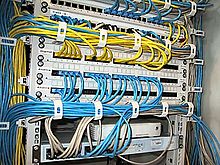Patch panel

A patch panel , also known as a patch panel or patch panel , is a connection element for cables that is used for patching , i.e. H. for the construction of complex cable structures in buildings. Patch panels are common for the distribution of network cables , telephone cables or fiber optic cables , especially for structured cabling . As a rule, it is one of the passive components of a network (see development ); Active components are, for example, switches or routers . It is primarily used as a 1-to-1 connection of complex cable systems in order to create a continuous connection between two points from several cables.
A patch panel provides a series of numbered sockets (also called ports ), terminals or solder strips into which cables can be plugged, clamped or soldered. On the rear wall, the sockets are provided with cables that establish connections to other patch panels or permanently installed junction boxes in the building. (The main task of patch panels is to create a connection between the rigid cables, which are permanently installed in walls, and the flexible patch cables.) In the case of network cables, modular jacks are usually used. A patch panel is generally a purely passive component and does not contain any active electronics, it only provides ports.
For larger installations, patch panels are mostly in 19- inch - distribution cabinets to all incoming cable to manage from a central point housed (48.3 cm). This increases the clarity in complex installations and makes maintenance easier. For smaller systems, e.g. B. in single-family houses, there are mini patch panels that are simply screwed to the wall.
Cables that are connected to the ports of a patch panel for routing are called patch cables .
development
Over time, patch panels evolve from “dumb” passive components to “intelligent” components. In addition to the option of supplying power to end devices as a midspan device ( Power over Ethernet ), patch panels are also available that report hardware faults using their own management software or indicate to the technician with a light-emitting diode on the patch panel which patch cables should be pulled and where they should be reinserted.

